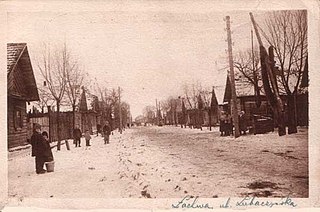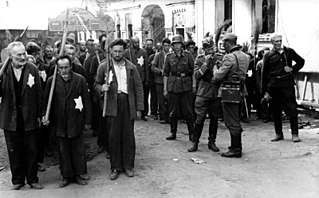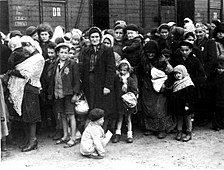
The Byelorussian Soviet Socialist Republic, also commonly referred to in English as Byelorussia, was a federal unit of the Soviet Union (USSR). It existed between 1920 and 1922, and from 1922 to 1991 as one of fifteen constituent republics of the USSR, with its own legislation from 1990 to 1991. The republic was ruled by the Communist Party of Byelorussia and was also referred to as Soviet Byelorussia by a number of historians.

The Reichskommissariat Ostland (RKO) was established by Nazi Germany in 1941 during World War II. It became the civilian occupation regime in the Baltic states and the western part of the Byelorussian Soviet Socialist Republic. German planning documents initially referred to an equivalent Reichskommissariat Baltenland. The political organization for this territory – after an initial period of military administration before its establishment – involved a German civilian administration, nominally under the authority of the Reich Ministry for the Occupied Eastern Territories led by Nazi ideologist Alfred Rosenberg, but actually controlled by the Nazi official Hinrich Lohse, its appointed Reichskommissar.

The ghetto uprisings during World War II were a series of armed revolts against the regime of Nazi Germany between 1941 and 1943 in the newly established Jewish ghettos across Nazi-occupied Europe. Following the German and Soviet invasion of Poland in September 1939, Polish Jews were targeted from the outset. Within months inside occupied Poland, the Germans created hundreds of ghettos in which they forced the Jews to live. The new ghettos were part of the German official policy of removing Jews from public life with the aim of economic exploitation. The combination of excess numbers of inmates, unsanitary conditions and lack of food resulted in a high death rate among them. In most cities the Jewish underground resistance movements developed almost instantly, although ghettoization had severely limited their access to resources.

Maly Trostenets is a village near Minsk in Belarus, formerly the Byelorussian Soviet Socialist Republic. During Nazi Germany's occupation of the area during World War II, the village became the location of a Nazi extermination site.

Lakhva is a small town in southern Belarus, with a population of approximately 2,100. Lakhva is considered to have been the location of one of the first, if not the first, Jewish ghetto uprisings of the Second World War.

The German occupation of Byelorussia, now known as Belarus, started with Nazi Germany's invasion of the Soviet Union on 22 June 1941 and ended in August 1944 with the Soviet Operation Bagration. The western parts of the Byelorussian Soviet Socialist Republic became part of the Reichskommissariat Ostland in 1941, but in 1943 the German authorities allowed local collaborators to set up a client state, the Belarusian Central Rada, that lasted until the Soviets liberated the region. During the occupation German actions led to about 1.6 million civilian deaths including 500,000 to 550,000 Jews in the Holocaust in Belarus.

Jewish partisans were fighters in irregular military groups participating in the Jewish resistance movement against Nazi Germany and its collaborators during World War II.

Skidzyelʹ is a town in the Grodno Region of Belarus located 31 kilometers from Grodno.

The Dzyatlava Ghetto, Zdzięcioł Ghetto, or Zhetel Ghetto was a Nazi ghetto in the town of Dziatłava, Western Belarus during World War II. After several months of Nazi ad-hoc persecution that began after the launch of Operation Barbarossa, the invastion of the Soviet Union, the new German authorities officially created a ghetto for all local Jews on 22 February 1942. Prior to 1939, the town (Zdzięcioł) was part of Nowogródek Voivodeship of the Second Polish Republic.

Jewish ghettos in Europe were neighbourhoods of European cities in which Jews were permitted to live. In addition to being confined to the ghettos, Jews were placed under strict regulations as well as restrictions in many European cities. The character of ghettos fluctuated over the centuries. In some cases, they comprised a Jewish quarter, the area of a city traditionally inhabited by Jews. In many instances, ghettos were places of terrible poverty and during periods of population growth, ghettos had narrow streets and small, crowded houses. Residents had their own justice system. Around the ghetto stood walls that, during pogroms, were closed from inside to protect the community, but from the outside during Christmas, Pesach, and Easter Week to prevent the Jews from leaving at those times.
The anti-Jewish violence in Central and Eastern Europe following the retreat of Nazi German occupational forces and the arrival of the Soviet Red Army – during the latter stages of World War II – was linked in part to postwar anarchy and economic chaos exacerbated by the Stalinist policies imposed across the territories of expanded Soviet republics and new satellite countries. The anti-semitic attacks had become frequent in Soviet towns ravaged by war; at the marketplaces, in depleted stores, in schools, and even at state enterprises. Protest letters were sent to Moscow from numerous Russian, Ukrainian and Belarusian towns by the Jewish Anti-Fascist Committee involved in documenting the Holocaust.

The Byelorussian Auxiliary Police was a collaborationist paramilitary force established in July 1941. Staffed by local inhabitants from German-occupied Byelorussia, it had similar functions to those of the German Ordnungspolizei in other occupied territories.

The Minsk Ghetto was created soon after the German invasion of the Soviet Union. It was one of the largest in Belorussian SSR, and the largest in the German-occupied territory of the Soviet Union. It housed close to 100,000 Jews, most of whom perished in The Holocaust.

Krupki is a small city in Krupki Raion, Minsk Region, Belarus.

The Grodno Ghetto was a Nazi ghetto established in November 1941 by Nazi Germany in the city of Grodno for the purpose of persecution and exploitation of Jews in Western Belarus.
Nikolay Yakovlevich Kiselyov, also commonly transliterated from the Russian language as Nikolai Kiselev, was a Soviet Red Army soldier, prisoner of war, and partisan leader during World War II.

Bronna Góra is the name of a secluded area in present-day Belarus where mass killings of Polish Jews were carried out by Nazi Germany during World War II. The location was part of the eastern half of occupied Poland, which had been invaded by the Soviet Union in 1939 in agreement with Germany, and two years later captured by the Wehrmacht in Operation Barbarossa. It is estimated that from May 1942 until November of that year, during the most deadly phase of the Holocaust in Poland, some 50,000 Jews were murdered at Bronna Góra forest in death pits. The victims were transported there in Holocaust trains from Nazi ghettos, including from the Brześć Ghetto and the Pińsk Ghetto, and from the ghettos in the surrounding area, as well as from Reichskommissariat Ostland.
Daniel Romanovsky is an Israeli historian and researcher who has contributed to the study of the Holocaust in the Soviet Union under German occupation in World War II. Romanovsky was a Soviet refusenik politically active since the 1970s. Private seminars on the history of the Jews were held in his Leningrad apartment in the 1980s. Research on the topic was difficult in the Soviet Union because of government restrictions. In the 1970s and 1980s Romanovsky interviewed over 100 witnesses to the Holocaust, including Jews, Russians, and Belarusians, recording and cataloguing their accounts of the Final Solution.

The Tarnopol Ghetto was a Jewish World War II ghetto established in 1941 by the Schutzstaffel (SS) in the prewar Polish city of Tarnopol.

The Słonim Ghetto was a Nazi ghetto established in 1941 by the SS in Slonim, Western Belarus during World War II. Prior to 1939, the town (Słonim) was part of the Second Polish Republic. The town was captured in late June 1941 by the Wehrmacht in the early stages of Operation Barbarossa. Anti-Jewish measures were promptly put into place, and a barb-wire surrounded ghetto had been created by 12 July. The killings of Jews by mobile extermination squads began almost immediately. Mass killings took place in July and November. The survivors were used as slave labor. After each killing, significant looting by the Nazis occurred. A Judenrat was established to pay a large ransom; after paying out 2 million roubles of gold, its members were then executed. In March 1942, ghettos in the surrounding areas were merged into the Słonim ghetto.



















